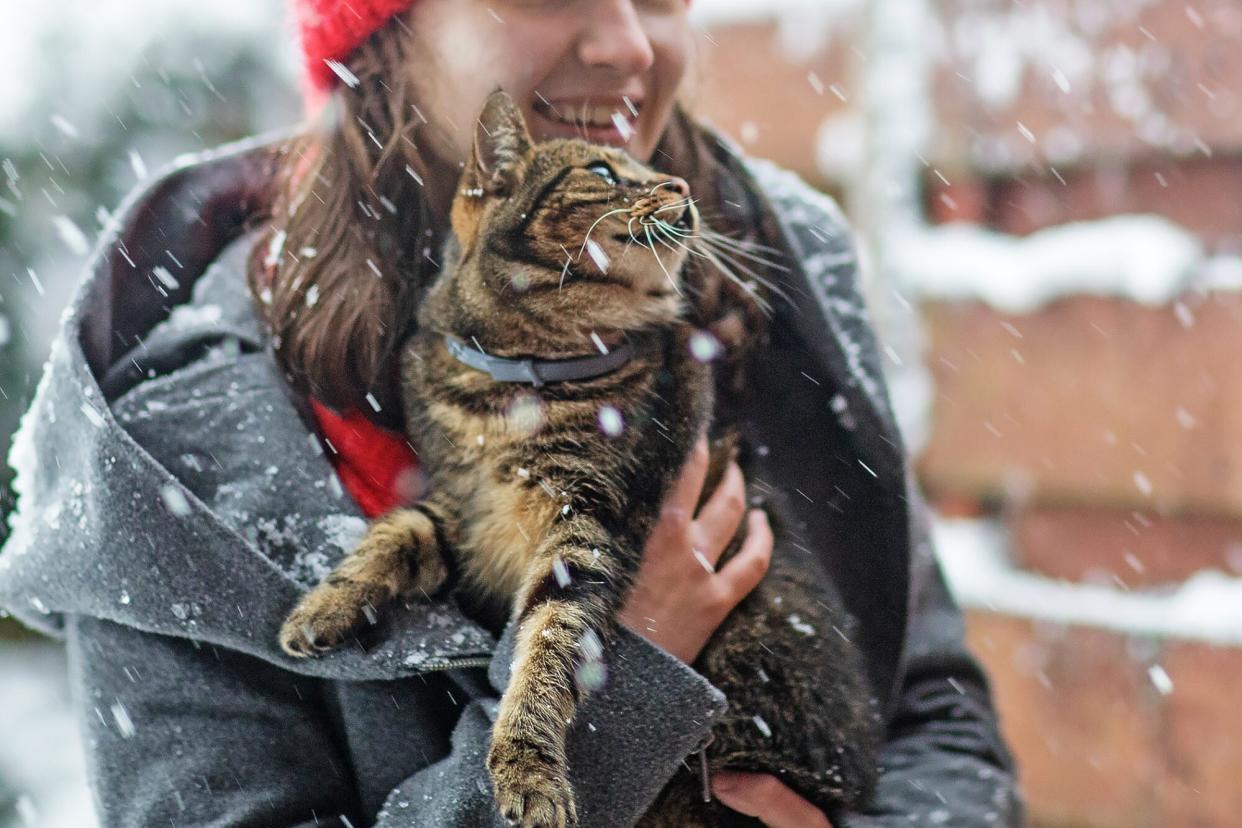Hypothermia in Cats: Here's What You Need to Know to Prevent and Treat This Medical Emergency

Lorado / Getty
Some cat breeds, like a floofy Norwegian forest cat, are somewhat adapted for cooler temperatures and snow. Maybe better adapted than you and me, Erin Katribe, DVM, MS, Medical Director of Best Friends Animal Society says. But, she warns, there are still cold-weather risks to watch out for and hypothermia in cats is one of those risks.
Hypothermia can occur when a cat's body temperature drops well below normal, usually due to cold weather and exacerbated in wet or windy conditions. Here's what to look out for when it comes to hypothermia in cats, plus prevention and treatment.
Can Cats Get Hypothermia?
A cat's coat does an exceptional job of keeping them warm, Katribe says. But even a sprinkle of rain or a gust of wind is no match for a cat on a cool day. When she gets cold and isn't able to warm up by shivering or finding a dry, warm spot, hypothermia could set in.
A healthy cat's body temperature is several degrees higher than a human's, around 101 to 102.5 degrees Fahrenheit. When a cat's body temperature drops and stays at 99 degrees Fahrenheit or below, she's at risk for this medical emergency.
Cats with underlying health conditions, kittens, and senior cats are most vulnerable to hypothermia. The cat's breed characteristics can also play a role—breeds like hairless cats are unable to trap and keep body heat like a chonky cat with long fur can.
Signs and Symptoms of Hypothermia in Cats
"Any environmental temperature near or below freezing can put animals at risk of hypothermia," Katribe says. Here's how to recognize the signs.
Shivering
When your cat is cold, she will begin to shiver. Shivering is a natural way to generate heat and will stop once the body is warmed to a comfortable temperature. In the case of hypothermia, shivering is not enough to generate the amount of heat being lost.
Cold Paws, Tail, Nose, and Ears
When shivering isn't enough, the blood flow from your cat's ears, paws, nose, and tail will be redirected to her core. This is her way of keeping her critical organs warm. Without blood flow, her appendages are vulnerable to frostbite, or the freezing of tissue.
Lethargy
As your cat tries to conserve body heat, she may stop looking for a heat source and curl up instead. At this stage, your cat might be experiencing moderate hypothermia and a core body temperature around 86 to 95 degrees Fahrenheit.
Pale Gums
As her core body temperature continues to drop and she progresses to severe hypothermia, her gums may become pale or grey in color.
Slowed Breathing and Heart Rate
As hypothermia becomes more severe, the heart rate and breathing will slow, Katribe explains. You may notice dilated pupils and unresponsiveness to your voice. A cat suffering from severe hypothermia may even collapse and enter a coma. Without immediate care, this could lead to death. Fortunately, hypothermia is preventable and with a quick response by humans, can be treated.
RELATED: Recognizing the Signs of Hypothermia in Dogs
How To Treat Hypothermia in Cats
At the first sign of hypothermia, bring your cat somewhere warm and dry. "For mild hypothermia, rewarming may be enough," Katribe says. "Bring the cat indoors into a heated area and apply warm blankets." Warm water bottles wrapped in towels can also be used to warm her, or your own body heat by cuddling your cat.
If a cat is demonstrating any severe signs of hypothermia, or if at-home warming techniques aren't working, your cat needs immediate veterinary care. If you're on the way to the vet, Katribe says not to stop warming with blankets. Even if your cat is unresponsive, recovery from hypothermia is possible with immediate treatment and with help from your vet.
How to Prevent Hypothermia in Cats
Luckily, hypothermia can be prevented in your cat and the feline that wandered into your yard. It can be hard to know how cold is too cold for your cat, but a general rule of thumb is anything below 45 degrees Fahrenheit is too cold without the right attire. Sweaters, rain jackets, and coats can all help keep your cat warm and dry. Or Katribe says, "Play it safe and stay indoors. If it's too cold for you outside, then it's likely too cold for your furry companion."
When you can't bring the neighborhood kitty indoors, bring the indoors to her with an outdoor heated cat house. If you're looking for inspiration for building your own outdoor cat abode, check out this amazing story about an Atlanta boy scout providing kitties with a warmer winter.
RELATED: The 13 Best Heated Cat Beds

